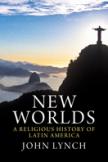Mission Territory
Latin America is a continent of believers, but what they believe defies simple classification. Catholics include ultraconservatives, traditionalists, Vatican II progressives and devotees of popular religion, which is a world in itself. Protestants (or evangélicos) range from mainstream to Mennonites and Pentecostals. Brazil and Haiti especially house many syncretic forms of African cults. And, of course there are Jews, especially in Argentina.
In this sweeping overview of religion from pre-Columbian days up to the present, John Lynch masterfully weaves together all these variant religious expressions into a very readable account. The author, former director of the Institute of Latin American Studies at the University of London, briefly overviews the pre-conquest religions and then moves on to cover the main theme of the whole book, Catholicism in its myriad forms.
This is more than a traditional church history: it is also a study of the underlying mentalities that influenced religious thought throughout Latin American history. The early missionaries attempted to evangelize the Amerindian population without really understanding the cultures of the Indians, who frequently accepted baptism without resistance. But the lack of overt resistance did not necessarily mean acceptance.
Lynch touches the heart of the problem when he notes that the missionaries did not understand the difference between culture and religion. Of course, religion is part of culture. But by imposing European cultural ways on the Amerindian and black populations, the missionaries did not understand that in fact many Indians did accept Christianity, but on their own cultural terms. Popular religiosity frequently arose in conflict with the official church. From the 16th century until today, two religious systems have coexisted in Latin American Catholicism: what the official church wants and demands, and what the people want and practice. The two systems were, and are, often at odds with each other.
The author covers all key aspects of the colonial church: Bartolomé de las Casas’ struggle in defense of the Indians, the Jesuit missions, the Inquisition (the Indians were exempt, but could still be investigated), Bourbon authoritarianism and the decline of church influence in the 18th century, as well as the emergence of creole nationalism. Everywhere creole priests took up the cause of independence, not so much for doctrinal reasons, but rather because they were patriots fighting for their homelands. The author takes the papacy and bishops to task for condemning the movement, a shortsightedness that aroused needless anger in Latin American liberals.
Lynch’s assessment of Romanization (by which Rome took charge of the Latin American church after the period of royal patronage) is balanced and acute: Latin American Catholics freed themselves from dependence on the state but became overly dependent on Rome. The church weathered the storms of anticlericalism and entered the 20th century relatively intact, and more conservative. But popular religion also went its own way. Although connected tenuously to the official church, lower class Latin Americans often supported charismatic figures who were rivals to the church. When Eva Peron died, 40,000 admirers wrote to Rome asking for her canonization.
The author’s portrayal of the church under the late 20th century dictators is very well researched and detailed. He covers the Central American countries where real martyrs gave witness to a living faith, especially El Salvador. Archbishop Miguel Obando in Nicaragua has often been criticized for not dialoguing with the Sandinista regime. But as Lynch points out, that regime was also very sectarian and in the end harbored corruption. Lynch’s assessment of the Argentinian church during the Dirty War military regime is fair. There were individual bishops who spoke privately to the generals, but sadly there was no public protest, collective outcry or defense of the “disappeared.” Cardinal Silva Henríquez and the Vicariate of Solidarity in Chile stand in stark contrast.
Naturally, the rise of Penteco-stalism, the religious expression of the majority of Latin American evangélicos, receives special treatment. Lynch suggests that Latin America is witnessing a “re-Christianization” from below and from above: from below because the poor are becoming Pentecostals, and from above because the wealthy and powerful are also being attracted to a form of religion that does not question their status. Lynch’s treatment of the Brazilian and Caribbean African cults, and especially the Jewish presence in Latin America, is very informative and enlightening.
The author reserves a special place for liberation theology. While sympathetic toward Gustavo Gutiérrez, O.P., he considers Leonard Boff´s treatment of Marxism and dependency theory a bit “naïve.” Nevertheless, whatever its limitations, as Lynch acknowledges, liberation theology did give a new vitality and sense of identity to a church excessively dependent on Rome. The author concludes that the Latin American church is now past the period of “Christendom,” but the future is very uncertain. Some bishops aim to reimpose a pre-Vatican II church, while others struggle to carry on the banner of the council.
One could quibble with small points. The author’s treatment of José de Acosta, a 16th century Spanish Jesuit in Peru famous for his missionary manuals on evangelizing the Indians, seems a bit harsh. He notes, correctly, that Acosta had no sympathy for pre-Christian religions, which he believed were infested with the devil. But Acosta’s greatest contribution to missiology was his call to missionaries to treat the Indians with kindness. All in all, however, this is a masterly, in-depth study of religion in its many forms in Latin America. Too often, secular histories marginalize religion or simply ignore it. But Lynch’s history should serve to remind all students that religion has always been at the core of Latin American culture and history.
This article also appeared in print, under the headline “Mission Territory,” in the October 22, 2012, issue.









